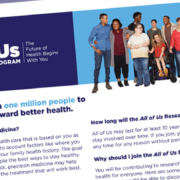Absolutely True, Relatively Meaningless
In this final Memo about the retraction of several of Dr. Brian Wansink’s publications, there are several important questions that need to be addressed. What do the errors mean? Did Dr. Wansink intend to deceive? Finally, who was making the accusations?
Publication Errors and What They Mean
Let’s take a look at the errors I mentioned on Thursday. The first was continually analyzing the data to come up with new hypotheses—that’s not the way research is supposed to be done. In this case, the data were collected via questionnaires after eating at a buffet in a small town restaurant. The purpose was to see if the price of the buffet influenced whether people felt better or worse about their food choices. This wasn’t the best study idea Wansink ever dreamed up; I don’t see the results of this study impacting the obesity epidemic in any way, even if the data were pristine and analyzed precisely without the data churn that came afterward.
The second error pointed out by the post-article reviewers all related to statistical errors. They questioned the data being carried out to the hundredths of a point and stated that there were errors in calculating the means. These were survey results using a Likert scale and should never have been presented other than in whole numbers or at best, to half a point; going to the hundredths just makes no sense. It would have been better to recommend that to the authors than make a big deal about deceptive statistical errors. They also found that the number of subjects continually changed in some analyses: one test said 122 subjects while another said 124. There may have been a degree of ineptitude but again, no attempt to overtly deceive.
Finally, regarding the plagiarism accusation. Wansink did what many authors do: he used prior text taken from his own prior publications and inserted them into articles as appropriate. They should have been cited, but when you re-use what you’ve already written that’s not plagiarism, that’s an oversight or a bone-headed error.
Did Dr. Wansink Attempt To Deceive?
I read Dr. Wansink’s blog post that started this whole mess. What he attempted to do was illustrate how new researchers can get published. He had no attempt to deceive anyone. As the blog got more play in the scientific universe, he took some pretty big hits and not in a nice way. He answered every one with respect, including several from one of the accusers.
I came away thinking that Dr. Wansink didn’t understand the ramifications of continually analyzing data with changing hypotheses. In addition, he was not the best statistician and would have been helped tremendously by help from someone who really understood numbers.
Who Were His Accusers?
I checked out three of the primary accusers, two of whom had published the article mentioned in Thursday’s Memo (1). They all seem to be fascinated with numbers and scientific purity.
One was a retired physics professor; in his entire academic career, he published two research papers and that was over 30 years ago. He was primarily a physics teacher and retired 19 years ago. My problem isn’t his age, it’s that he hadn’t done much in his own field, let alone Wansink’s.
A second is a PhD candidate in the social sciences. If anyone understands the mess the use of observation and questionnaire testing can present in behavioral research, it would be him. It’s curious that he wouldn’t make that a key element of his paper.
The final accuser was a PhD/MD candidate who was kicked out of his program by his advisors, according to his blog. That gave him plenty of time to do the most in-depth and longest review of Wansink’s papers.
This may sound cruel but what we have is a never-was, a wannabee with very limited experience, and a never-will-be. Not exactly a stellar cast of accusers. They were absolutely correct, but what they showed is relatively meaningless.
What I didn’t see was a review of Wansink’s paper on the never-ending soup bowl (2), maybe because it was based on actual numbers because the amounts of soup were measured. They also failed to mention that another study was replicated and confirmed by another lab (3); it was on how the names of food influences whether children and young adults will eat more vegetables.
The Bottom Line
In spite of the publications being retracted, and with that, the forced retirement of Dr. Wansink from his Lab, there’s still value in the research that he’s published. He seemed to be more an idea guy than a bench scientist. Makes sense: his PhD was in marketing so he tried to research people’s attitudes about food. He just didn’t know how to do it very well from a science perspective.
If you want to control your eating, use a smaller plate, plate your food away from the table and don’t add any more, and keep all snacks out of sight. Proof or no proof, those are still good recommendations.
What are you prepared to do today?
Dr. Chet
References:
1. BMC Nutrition. doi.org/10.1186/s40795-017-0167-x.
2. Obes Res. 2005 Jan;13(1):93-100.
3. AMA Intern Med. 2017;177(8):1216-1218. doi:10.1001/jamainternmed.2017.1637






 AllOfUsInfo
AllOfUsInfo

